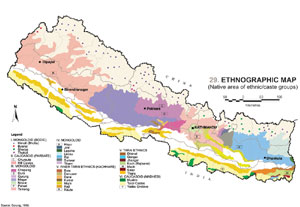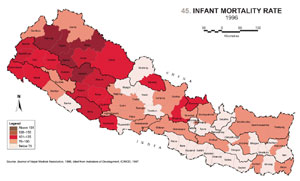 For those interested in the mapping of Nepal, 2006 was a tragic year in which we lost Dr Harka Gurung, one of the foremost exponents of social demography. But 2006 was also the year in which three atlases based on data from the 2001 Census of Nepal were published, each with Dr Gurung as principal author or editor. Each of them tells us about the unique and changing nature of modern Nepal.
For those interested in the mapping of Nepal, 2006 was a tragic year in which we lost Dr Harka Gurung, one of the foremost exponents of social demography. But 2006 was also the year in which three atlases based on data from the 2001 Census of Nepal were published, each with Dr Gurung as principal author or editor. Each of them tells us about the unique and changing nature of modern Nepal.
Cartography is a curious discipline, highlighting relations between data sets in two- or three-dimensional space. Maps, and the statistics which underlie them, can provide a visually rich snapshot of reality in a manner words can rarely achieve. But maps can also be deceptive and inaccurate, or manipulated for political effect. Poorly constructed or inexact maps are potentially dangerous when they enter the public domain, precisely because of their immediately definitive power as markers of spatial reality.
The Nepal Atlas of Ethnic and Caste Groups and the Nepal Atlas of Language Groups, both published in 2006, were the swansong of the outgoing Chairman of the National Foundation for Development of Indigenous Nationalities (NFDIN), Professor Sant Bahadur Gurung, who also wrote the Foreword to each. Both priced at Rs 500, these publications should be thought of as one atlas in two volumes, providing district level information on 103 officially recognised ethnic groups and 93 officially recognised languages. The difference between these two figures is already worth some thought, for in Nepal there is no one-to-one correlation between language and ethnic group.
 Combining the analytical insights of Harka Gurung with census data analysis by Yogendra Gurung and the map-making skills of Chhabi Lal Chidi, these two volumes offer the kind of baseline data that policy makers, development workers, and academics need for their work. The black and white maps are not by themselves scintillating, but they do provide the relevant census data on the left hand page with a visual representation on the right. Pages 227 to 266 are particularly helpful, providing population counts by language and ethnic group for each of Nepal's 75 districts.
Combining the analytical insights of Harka Gurung with census data analysis by Yogendra Gurung and the map-making skills of Chhabi Lal Chidi, these two volumes offer the kind of baseline data that policy makers, development workers, and academics need for their work. The black and white maps are not by themselves scintillating, but they do provide the relevant census data on the left hand page with a visual representation on the right. Pages 227 to 266 are particularly helpful, providing population counts by language and ethnic group for each of Nepal's 75 districts.
In both his twelve-page introductions, Dr Gurung unpacks the data in his trademark manner, carefully comparing and disaggregating census findings to make interesting points. He is also justifiably sceptical about the underlying data sets, suggesting that "the census data records too many cases of a language population exceeding their related ethnic group population in almost all districts. Such a widespread anomaly could have been due to misreporting and misrecording of ethnic and linguistic data" (page 10). The ever-careful scholar was being generous: the 2001 census, while better than any earlier one, is full of holes, particularly regarding languages and ethnicities. One example of census fallibility records 168,340 speakers of unspecified languages (pages 224-225). This is an unacceptably high number, implying a poor choice of categories used by the enumeration team. Every language has a name!
 In all, though, the NFDIN books are strong, data-heavy publications which could also be hosted online or archived on a CD. As with all publications from the foundation, distribution remains the stumbling block, as they are not easily found in bookshops even in Nepal.
In all, though, the NFDIN books are strong, data-heavy publications which could also be hosted online or archived on a CD. As with all publications from the foundation, distribution remains the stumbling block, as they are not easily found in bookshops even in Nepal.
Published by Himal Books, Nepal Atlas and Statistics is a colourful and varied introduction to a wide range of data sets concerning Nepal. Grouped into categories entitled Setting, Physical Basis, Socio-Cultural Aspects, Economic Sectors, and Development Indicators, this atlas is a collection of 95 maps and five diagrams accompanied by related statistical tables. The statistics all derive from government sources, so they are as good and bad as the data in the NFDIN publications. Still, many of the maps are vivid and well-constructed, such as the one depicting the Infant Mortality Rates in 1996 (page 95), in which the western districts of Bajura, Bajhang, Jajarkot, Kalikot, and Mugu show the highest number of deaths. (above, centre).
Intriguing and unexpected maps include one on Registered Legal Cases in 2001 and another on Reported Criminal Cases, both of which show significantly higher numbers in the tarai. Are plains dwellers more litigious, at least on paper, or are lowland cases just better reported? Does higher population density play a role? These are just some of the questions which good maps prompt one to consider. Two other maps which stand out are Map 3 (below), providing a visual depiction of the Gorkhali expansion of the late 18th century, and Map 4 (above), which offers the reader a glimpse of a greater Nepal.
Two other maps which stand out are Map 3 (below), providing a visual depiction of the Gorkhali expansion of the late 18th century, and Map 4 (above), which offers the reader a glimpse of a greater Nepal.
Sadly, the rich colours and vividness of some of the maps are also their undoing. Map 51 of Higher Secondary School Enrolment is so dark, that all the shades of blue effectively blend into one, while the varying hues of green in Map 79 on Agricultural Credit cannot be disambiguated from one another, creating an over-saturated mush. I doubt whether Dr Gurung, being a perfectionist, would have found such maps acceptable for public consumption.
The three books under discussion provide important background data on many aspects of the composition of modern Nepal, and will be essential additions to collections committed to the dissemination and production of knowledge on this country.
Mark Turin is director of the Digital Himalaya Project and fieldwork coordinator for the Chintang and Puma Documentation Project (CPDP) based at Tribhuban University.
Gurung, Harka, Yogendra Gurung and Chhabi Lal Chidi. 2006. Nepal Atlas of Ethnic and Caste Groups. Kathmandu: National Foundation for Development of Indigenous Nationalities. ISBN 99946-823-3-4. Rs 500.
Gurung, Harka, Yogendra Gurung and Chhabi Lal Chidi. 2006. Nepal Atlas of Language Groups. Kathmandu: National Foundation for Development of Indigenous Nationalities. ISBN 99946-823-4-2. Rs 500.
Gurung, Harka (ed.). 2006. Nepal Atlas and Statistics. Kathmandu: Himal Books. ISBN 99933-43-72-2. Rs 700.


